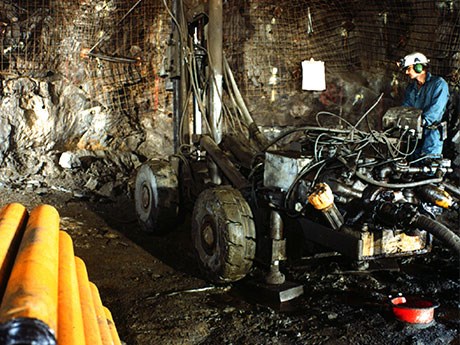North Bay’s iRing Inc. unveils new blasting software
New blasting software, developed by a North Bay company, adds speed and precision to the science of carving riches from the depths of underground mines.
iRing, Inc. released its Aegis Designer software in December to a “jaw-dropping” reaction from mine planners who watched the software at work.
Professional engineer Troy Williams, iRing’s lead software developer, recalls a recent demonstration in which he used Aegis to create a three-stope blasting scenario for a mining company.
“I was told one of their planners spent about three weeks on it. We did the whole thing, including reports, in less than an hour,” said Williams, a software designer for 14 years.
Specialists in underground blasting applications, consulting, training and research, iRing’s team developed an earlier version of blasting software to optimize ore recovery and fragmentation. Called iRing, that software is used by mines in Canada, Australia and Africa.
In development for about three years, Aegis Designer is a completely new concept, says professional engineer Chris Preston, iRing’s project manager.
“It’s totally self-contained,” he said. “It designs blasting scenarios extremely fast, so in laying out a stope, which might take a week, 10 days, or even two weeks (using conventional methods), we can do it in less than two or three seconds.”
Aegis is designed to be intuitive. It is not based on Computer-Aided Design programs like AutoCAD or MineCad that require mine planners to use a multiplicity of individual tools in a time-consuming process to design blasting rings, the pattern of drill holes and explosives used to cleave ore from host rock.
“Our Aegis programs will replace all the CAD systems that are out there,” said Preston. “That’s our goal for ring design.”
Software developers wanted to provide mine developers with a means of designing blocks in entire stopes in a fraction of a second.
“We accomplished that,” said Preston. “Because Aegis does things so quickly, planners now have the time to actually plan and will be spending less time preparing prints, drawings and reports. They can go underground and open up more work spaces. They can generate more material at a profit.”
In an on-line demonstration, Williams showed how the software can quickly design a blasting ring pattern for an entire stope.
“We’ve laid out 10 or 15 rings in the blink of an eye,” he said.
The program allows mine planners to work in three views simultaneously and to compare the costs and effectiveness of ring patterns and explosives-loading strategies. They can rapidly design or modify all aspects of ring design, including drilling, explosives loading, priming and timing.
“There’s complete flexibility in what’s available to be manipulated,” said Preston.
A reporting mechanism can create layouts to send underground to drillers.
“We can generate charging reports that can go to the loaders underground so that they know how they need to load the patterns,” Preston said. Summary reports can also generate costs associated with blasting rings and charges.
Aegis supports the International Rock Excavation Data Exchange Standard (IREDES) data exchange format for drills. It can generate files for drills that can automatically drill holes based on that data, Preston said.
With Aegis, mine planners can depict in three dimensions the break expected from a specific loading of drill holes and calculate expected ore volume.
“We can actually assign a fragmentation distribution to this blast,” said Preston. “This is useful because when you attach the fragmentation distribution, you’re actually assigning the configuration of that blast. So, presumably, if you load the next rings the same way, you would be able to predict what the fragmentation profile will be.”
Optimal fragmentation is key to maximizing mine productivity. iRing’s new Aegis Analyzer software visually illustrates how a planned blast will work.
“You can see the shock waves from the explosive. You can also see the shear waves going out through the blast,” said Preston. “It’s a nice way of graphically showing a plan of what is going to happen when they fire the blast.”
Aegis generates an accurate picture of fragmentation, along with the cost of getting the exact fragmentation profile required for the mine’s existing equipment, he explained.
iRing’s designers, including mathematicians Robert Elkins and Jonathan Zimmerling, who were key to developing the science behind the software, realized they could potentially use each blast and its associated parameters in such a way that it becomes a primary crusher, Preston said. They expect precise, underground blasting with consistent fragmentation will someday eliminate the need for expensive underground jaw crushers or gyratory crushers.
“We feel that in time, using this program, we’ll get enough data and we’ll be able to treat the drilling and blasting as a manufacturing process,” he said.
Funded in part by the National Research Council’s Industrial Research Assistance Program, the Aegis software is now being marketed, tested and evaluated by iRing’s partners CAE Mining and MineRP in conjunction with their customers.
iRing is also doing a special trial with a Canadian gold miner.



